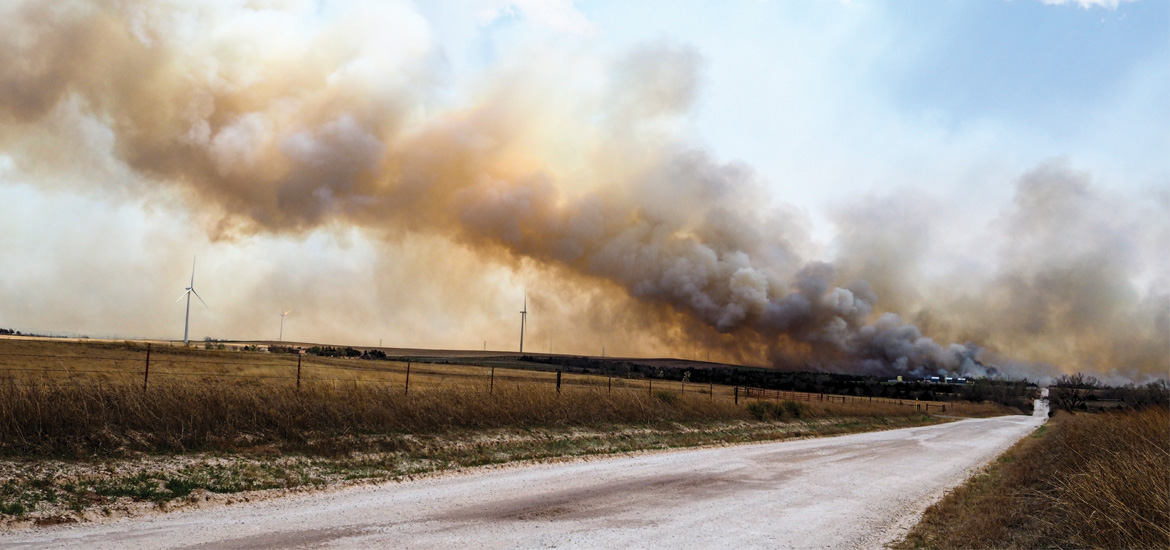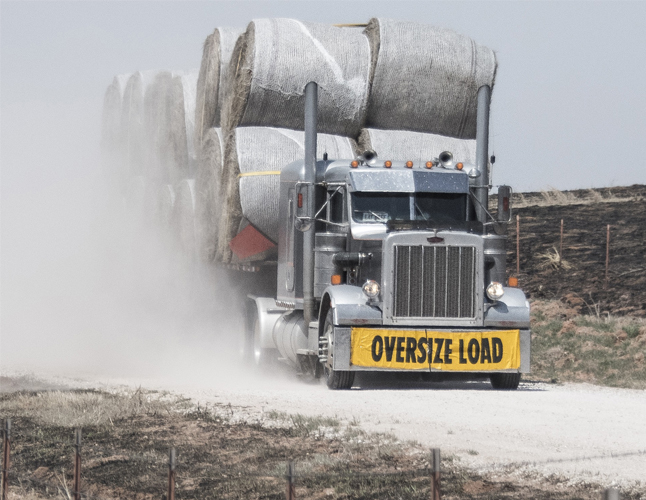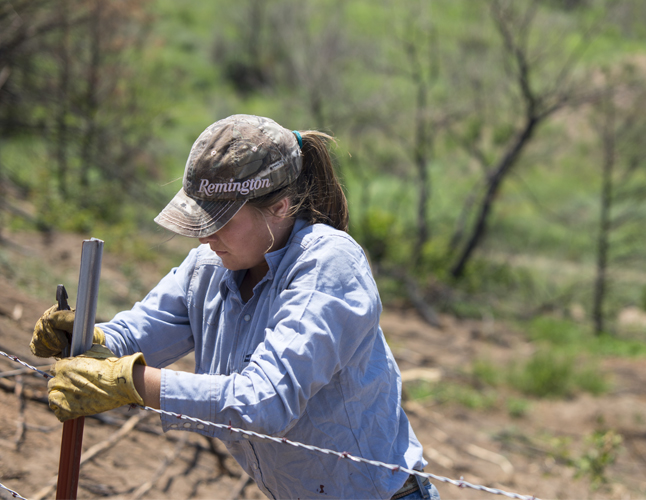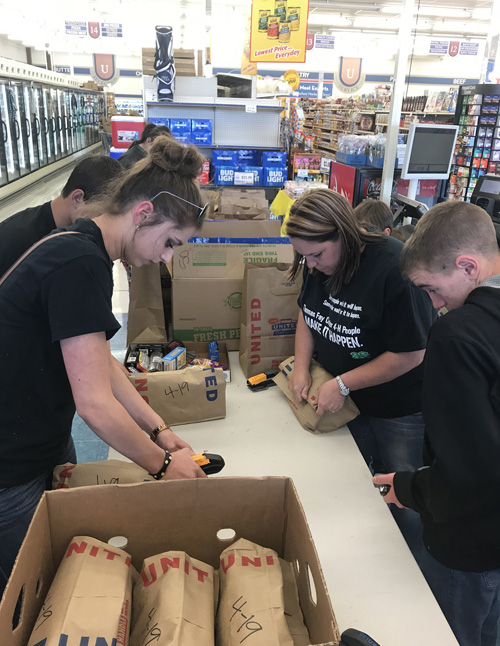
Helping in a Heartbeat
Wednesday, August 1, 2018
OSU family offers aid to those affected by April’s massive wildfires
By Donald Stotts and Trisha Gedon
Wind-swept wildfires raged across northwestern Oklahoma in April, scorching nearly 350,000 acres and threatening to burn down the lives of anyone whose home and property were in their paths. Dewey and Woodward counties were hit particularly hard.
Within 24 hours of the first wildfire on April 12, the Oklahoma Cooperative Extension Service — one of two state agencies administered by Oklahoma State University’s Division of Agricultural Sciences and Natural Resources— had already been tapped by the State Office of Emergency Management to take the lead in organizing agricultural related relief efforts for affected counties.
“It made perfect sense in that Extension has a local, regional and statewide presence, plus we had coordinated the nationwide relief effort to help Oklahoma victims of the historic 2017 blaze that devastated Woodward, Harper and Beaver counties,” said Dee Cooper, OSU Cooperative Extension director for the state’s western district.

The agency matched up producer needs with donations of supplies such as hay, supplemental livestock feed, milk replacer for calves that lost their mothers and fencing supplies to restore boundaries and protect wandering animals. Three telephone contact numbers were created to manage the influx of calls.
In addition, Extension state and county websites showcased contact information, answers to frequently asked questions and recommendations to assist farm families in making key decisions, both for their own quality of life and their agribusinesses. However people got their information — through the media, meetings, reading materials, video presentations or through individual conversations — Extension experts were out in full force, helping people to get the help they needed or the information needed to help themselves.
“Our intent was to move things along as speedily as possible given the urgent needs many people had,” Cooper said. “It wasn’t just our Extension professionals in the affected counties; county Extension educators and area, district and state subject-matter experts from across Oklahoma stepped up to help out, as they always do. The good-neighbor policy is one of our hallmarks.”
One particular challenge came in the form of national weather patterns and market forces that resulted in hay being in short supply. Livestock that had survived being burned or asphyxiated by the wildfires needed pastures, but those had been turned into a charred, blackened landscape.
“Farmers and ranchers across Oklahoma and in other states were making available what hay they could but the supply was simply less than what had been available in 2017,” said Dana Bay, OSU Cooperative Extension agricultural educator for Woodward County and one of the key organizers of DASNR’s 2018 wildfire recovery efforts. “A number of livestock producers who had managed to save their animals wound up having to sell part or all of their herds because they just didn’t have any way to adequately feed them.”
In addition to managing supply donations and getting them into the hands of those in need, OSU Cooperative Extension matched up individuals and groups who wanted to donate their time and effort with producers needing help to rebuild fences, transport hay and similar activities.
Down but not out
Sometimes those in need were familiar faces, including some Extension employees themselves. Cindy Charboneau of the Woodward County Extension Office lost her home. Charboneau was at work and was left with what she had worn that day plus a gym bag in which she had tossed shorts, a top and not much else. Her husband Francis had what he was wearing plus a jacket and a fishing pole in his vehicle. The inferno that engulfed their home consumed everything else.
“It was pretty demoralizing,” Charboneau said. “We were in shock, repeatedly as we ran into situations where we realized we didn’t have this or that anymore. We were fortunate to find a local house up for sale that was empty, and we were allowed to rent it. Then we worried about whether our home would be rebuilt before somebody bought the house we were renting.”
Harmon volunteer Fire Chief Justin Barr, an Ellis County Extension agricultural educator, was out fighting wildfires when he learned his own pastureland in Dewey County was ablaze.

“It’s kind of burned into the brain: It was a Thursday when the wildfires started, we got paged around noon and were off for Woodward County,” he said. “There was a point where we got rerouted. We went where we were needed but around 3 p.m., I was told my family’s place was in the path of an oncoming wall of fire.”
Barr contacted his wife and started evacuating their cattle to a safer locale. His family owns what Barr calls his “personal fire truck, complete with pump” that he utilizes to manage controlled prescribed burns on the family operation. It was put to good use. The livestock were saved, except for two animals, which somehow — miraculously, Barr said — wandered in the next day.
“We didn’t lose any animals, but we did lose 1,400 acres of grassland and roughly 14 miles of fencing,” he said. “We were able to salvage about eight miles of fencing. We saved some money by doing it ourselves, but it was hard work plus the cost of supplies.”
Very hard work. Parts of the Barr property feature expansive washes that drop two to four times the distance one might experience riding the largest rollercoasters. “It’s not easy putting fences in those places,” he said. “We wound up budgeting about $75,000 to get everything back up.”
Some 1,600 head of cattle were lost and more than 2,100 miles of fences were affected. The totals did not include vehicle and equipment losses or homes or other personal property the fires destroyed. There were also the significant and long-lasting financial impacts on agricultural operations and the families affected.
“You would like to take time off and take care of your own needs but being an Extension educator, you go into the office and go around the county making sure everyone else is doing what they need to be doing to be successful,” Barr said.
It was much the same for Mike Weber, Dewey County agricultural educator, whose family farm operation also was a wildfire victim of the state’s biggest blaze that lasted more than a week. “I was out meeting with some of the families and they were just overwhelmed emotionally,” he said. “But one of the things I was able to talk about was how the Oklahoma 4-H Foundation had set up a special wildfire recovery account.”
The power of green
Oklahoma 4-H, the youth development arm of the Oklahoma Cooperative Extension Service, raised approximately $55,000 through the foundation, with applications for assistance being taken through June and disbursement of funds expected in August and September.
“There were about 20 families in Dewey County in need of the assistance,” said Jim Rhodes, Western District 4-H program specialist for OSU Cooperative Extension. “The amount of funds received varied based on what was lost: house, barn, fencing, project animals. No 4-H family in Woodward County reported losses (at) the level of those in Dewey County.”
Nor did 4-H’s involvement end there. Oklahoma club members often lend a helping hand to fulfill community needs. Club members in Custer County came together to make sack lunches for the hundreds of firefighters who were out battling the blazes.
“One of my 4-H parents is a manager at the United grocery store, and they had been contacted by the Oklahoma Forestry Services to prepare sack lunches for the firemen,” said Jordan Nel, OSU Cooperative Extension 4-H educator for Custer County. “The store contacted us to see if we could help assemble the meals.”
Consider it done. They packed some 1,225 meals. Forestry Services picked up the meals and took them to the command center that had been set up at Southwestern Oklahoma State University in Weatherford, where many firefighters were housed. The 4-H youth went in after school to help prep the sacks, which included candy bars, fruit, beef jerky, cookies, silverware and whatever else was available. The sandwiches were added the next morning just prior to delivery.

Custer County 4-H’ers assisted in other ways as well, including an agricultural-relief donation drive at Tractor Supply in Weatherford, said Radonna Sawatzky, OSU Cooperative Extension family and consumer sciences and 4-H Youth Development educator.
“We received $8,000 worth of donations that included feed, fencing supplies, milk replacement and veterinary supplies that went to Dewey County,” she said. “We also were able to donate a cattle trailer full of personal items to those who lost their homes in Vici.”
In addition, Oklahoma Home and Community Education groups in Custer, Jackson and Greer counties put together bags with shampoo,soap, toothbrushes, toothpaste, razors, washcloths and other small personal necessities for the firefighters.
Liz Nicholson, 4-H educator in Canadian County, had nearly 50 club members, ranging from Cloverbuds to Teen Leaders, working on wildfire relief. They coordinated efforts to collect items to assist with cleanup and rebuilding fences: post drivers, five- gallon buckets, trash bags and gloves, and worked to provide donations of feed for horses, cattle, pigs, goats and sheep.
“Our younger 4-H’ers believed it was important to help people that help us. They don’t really understand agricultural loss at their age, so they relate closer to the firefighters,” Nicholson said. “The older kids have an entirely different outlook on things. They saw the damage done and immediately wanted to know how they could help.”
A community of cooperation
Not to be overlooked is another key aspect of OSU Cooperative Extension’s wildfire recovery effort — directing people to much-needed aid provided through many of its longtime cooperating partners.
“Go to an Extension meeting, and you will regularly see sponsors who feel it is important to support what we do and what we provide Oklahoma residents and communities,” Bay said. “They responded in a big way to help with wildfire relief.”
The Oklahoma Farm Credit Associations established a $200,000 fund to support those affected by the fires. CoBank contributed an additional $200,000. “As of May 9, $368,000 had already been disbursed,” said Kristin Zollinger, a 2003 OSU agricultural communications graduate and member of Farm Credit of Western Oklahoma’s Woodward office.
In addition, Farm Credit of Western Oklahoma rolled out a loan program specifically for wildfire victims. The program offered zero percent interest loans for six months to operators affected by the fires who needed immediate operating funds.
The Oklahoma Farming and Ranching Foundation, a 501(c)(3) non-profit organization, created a matching program to partner with Oklahoma’s 4-H clubs and FFA chapters to raise funds for rural volunteer fire departments in areas affected by the wildfires.
“This is our extended OSU family at work,” Bay said.
OSU Cooperative Extension’s closest cooperating partner may have been the Oklahoma Cattlemen’s Association Foundation, which had been tapped by the State Office for Emergency Management to handle monetary donations for agricultural enterprises affected by the wildfires.
“Fully 100 percent of received donations went to impacted families,” said Michael Kelsey, OCA executive vice president. “We’re proud to have done our part. I want to say Extension really stepped up, which happens so often people might take it for granted. All the ways Extension responded to the crisis was truly impressive, and everyone should take note.”
"This is our extended OSU family at work."
